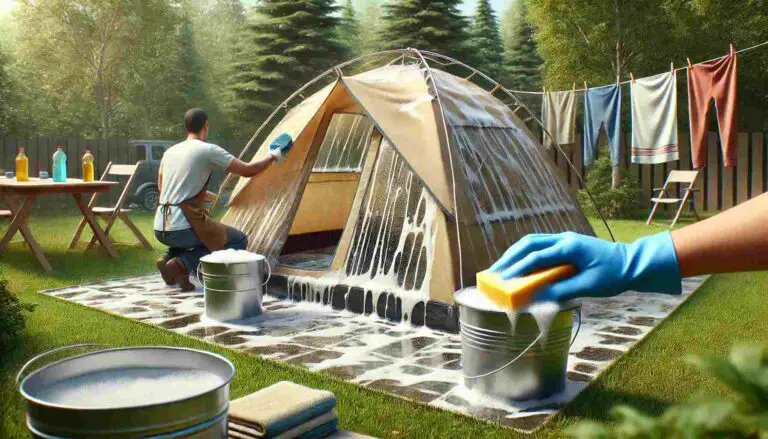A dry tent not only guarantees a comfortable sleep but also protects your gear and keeps you safe from the elements. This comprehensive guide will walk you through the essential steps to waterproof your tent, backed by accurate information, helpful statistics, and practical tips.
Why Waterproofing Your Tent is Important
Waterproofing your tent is crucial for several reasons:
- Comfort: A dry tent ensures you stay warm and comfortable, preventing a miserable camping experience.
- Gear Protection: Wet conditions can damage your gear, from sleeping bags to electronics.
- Safety: Prolonged exposure to wet conditions can lead to hypothermia and other health issues.
- Longevity: Regular waterproofing extends the life of your tent by preventing mold, mildew, and fabric degradation.
Understanding Tent Fabrics and Waterproof Ratings
Tents are typically made from materials like polyester, nylon, or canvas, each with unique waterproofing needs. Waterproof ratings, measured in millimeters (mm), indicate the fabric’s ability to resist water pressure. A tent with a rating of 1,500mm or higher is considered waterproof.
Types of Tent Fabrics
- Polyester: Lightweight, durable, and often used for budget tents. It requires regular waterproofing.
- Nylon: Stronger than polyester and used in high-end tents. It benefits from additional waterproofing treatments.
- Canvas: Naturally water-resistant but heavy. Requires less frequent waterproofing but still needs maintenance.
Waterproof Ratings
- 1,500mm: Suitable for light rain.
- 3,000mm: Handles moderate rain.
- 5,000mm and above: Ideal for heavy rain and extreme conditions.
Steps to Waterproof Your Tent
1. Clean Your Tent
Before applying any waterproofing treatment, ensure your tent is clean. Dirt and debris can interfere with the effectiveness of waterproofing sprays and sealants.
Materials Needed:
- Mild soap
- Water
- Soft brush or sponge
Steps:
- Pitch your tent and remove loose dirt with a brush.
- Mix mild soap with water and gently scrub the tent fabric.
- Rinse thoroughly with clean water.
- Allow the tent to dry completely before proceeding.
2. Seal the Seams
Seams are the most vulnerable parts of a tent where water can seep through. Sealing them is essential for complete waterproofing.
Materials Needed:
- Seam sealer (compatible with your tent fabric)
- Applicator brush
Steps:
- Lay the tent flat and identify all seams.
- Apply the seam sealer generously along the seams using the applicator brush.
- Allow the sealer to dry as per the manufacturer’s instructions.
3. Apply a Waterproofing Spray
Waterproofing sprays add an extra layer of protection to your tent’s fabric, enhancing its water resistance.
Recommended Products:
Steps:
- Pitch your tent in a well-ventilated area.
- Shake the waterproofing spray can well.
- Evenly spray the entire tent fabric, maintaining a consistent distance.
- Focus on high-wear areas like the tent floor and rainfly.
- Allow the tent to dry completely before packing it away.
4. Reapply Waterproofing Treatments Regularly
Regular maintenance is key to ensuring your tent remains waterproof. Reapply treatments at least once a year or more frequently if you camp often in wet conditions.
Top Waterproof Tent Options on Amazon
Investing in a high-quality waterproof tent can save you time and effort in maintenance while ensuring maximum protection against the elements. Here are some of the top-rated waterproof tents available on Amazon, featuring excellent customer reviews and proven performance in various weather conditions.
1. Coleman WeatherMaster 6-Person Tent
The Coleman WeatherMaster 6-Person Tent is designed to withstand heavy rain and wind, making it a reliable choice for family camping trips.
- Waterproof Rating: 2,000mm
- Features: Patented WeatherTec system, waterproof floor, spacious interior
- Price: Check the current price on Amazon
- Customer Reviews: 4.5 out of 5 stars
2. ALPS Mountaineering Lynx 1-Person Tent
Perfect for solo adventurers, the ALPS Mountaineering Lynx 1-Person Tent offers excellent weather protection and is easy to set up.
- Waterproof Rating: 1,500mm
- Features: Factory-sealed seams, free-standing design, ample ventilation
- Price: Check the current price on Amazon
- Customer Reviews: 4.7 out of 5 stars
3. CORE 9-Person Extended Dome Tent
Ideal for large groups, the CORE 9-Person Extended Dome Tent offers spacious accommodations with superior waterproofing.
- Waterproof Rating: 2,000mm
- Features: H2O Block Technology, adjustable ventilation, gear loft with lantern hook
- Price: Check the current price on Amazon
- Customer Reviews: 4.6 out of 5 stars
4. Teton Sports Mountain Ultra Tent
The Teton Sports Mountain Ultra Tent is built for rugged conditions, providing reliable waterproofing and durability.
- Waterproof Rating: 3,000mm
- Features: Micro-mesh inner tent, full-coverage rainfly, easy setup
- Price: Check the current price on Amazon
- Customer Reviews: 4.6 out of 5 stars
5. MSR Hubba Hubba NX 2-Person Lightweight Backpacking Tent
For backpackers seeking a lightweight yet highly waterproof option, the MSR Hubba Hubba NX 2-Person Tent is an excellent choice.
- Waterproof Rating: 1,200mm
- Features: DuraShield coating, StayDry doors, compression stuff sack
- Price: Check the current price on Amazon
- Customer Reviews: 4.8 out of 5 stars
Additional Tips for Tent Waterproofing
- Groundsheet: Use a groundsheet to protect the tent floor from moisture and abrasion.
- Rainfly: Always use the rainfly, even in dry conditions, for added protection.
- Ventilation: Proper ventilation reduces condensation inside the tent, keeping it dry.
- Storage: Store your tent in a cool, dry place to prevent mold and mildew growth.
Common Waterproofing Mistakes to Avoid
- Skipping Seam Sealing: Neglecting to seal seams can render other waterproofing efforts ineffective.
- Using Harsh Cleaners: Strong detergents can damage tent fabrics. Stick to mild soap.
- Improper Drying: Ensure the tent is completely dry before storing to prevent mold and mildew.
- Inconsistent Application: Apply waterproofing treatments evenly to avoid weak spots.
FAQs about Tent Waterproofing
How often should I waterproof my tent?
Ideally, you should waterproof your tent at least once a year. If you camp frequently in wet conditions, consider reapplying treatments every few months.
Can I use household waterproofing products?
It’s best to use products specifically designed for tents. Household waterproofing sprays may contain chemicals that can damage tent fabrics.
How can I tell if my tent needs waterproofing?
Signs that your tent needs waterproofing include visible water seepage, dampness inside the tent, and worn-out seams.
What should I do if water still leaks after waterproofing?
Check for missed spots or damaged areas in the tent fabric. Reapply the waterproofing spray and seam sealer as needed. If leaks persist, it may be time to invest in a new tent.
Conclusion
Waterproofing your tent is an essential skill for any camper, ensuring a dry, comfortable, and safe camping experience. By understanding the importance of waterproofing, knowing your tent’s fabric and waterproof rating, and following the proper steps to clean, seal seams, and apply waterproofing treatments, you can significantly enhance your tent’s performance in wet conditions.
Regular maintenance and avoiding common mistakes will further ensure that your tent remains in top condition, ready for any adventure nature throws your way.



